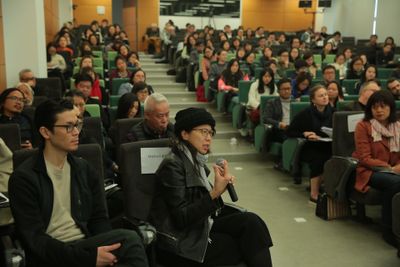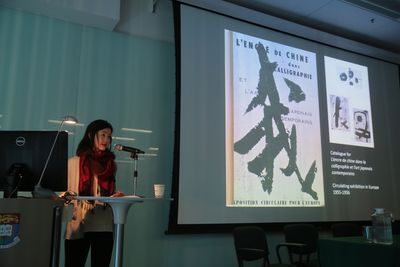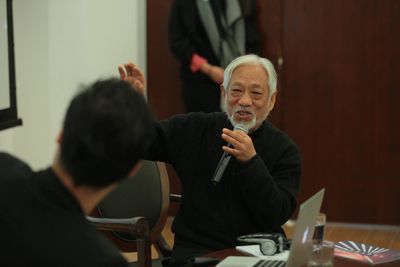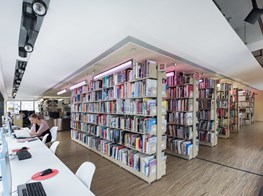It Begins With A Story: Artists, writers, and periodicals in Asia
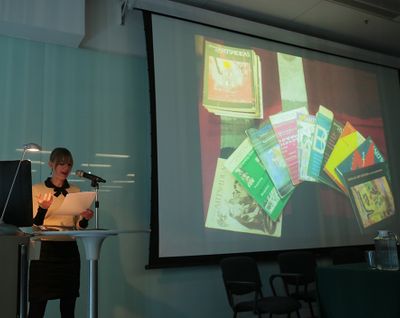
Sophia Powers, The Journal of Art and Ideas: A Genealogy of Transition, It Begins with a Story: A symposium on artists, writers, and periodicals in Asia, The University of Hong Kong (HKU) (11–13 January 2018). Courtesy Asia Art Archive. Photo: Cheung Chi Wai.
Art periodicals are 'more than mere containers of memory, experience and knowledge,' explained Asia Art Archive researcher Chương-Đaì Võ in her introduction to It Begins With A Story: A symposium on artists, writers, and periodicals in Asia, the three-day symposium co-organised by AAA and the Department of Fine Arts at The University of Hong Kong (HKU) (11–13 January 2018). Rather, Võ noted, periodicals are 'active sites of expression'—a remark that called attention to the contemporary relevance of such publications, even if no longer in print. Emphasising the foundational role of journals and magazines in the 'heralding of what has become known as art criticism and art historical practice', Võ effectively laid the groundwork for the 12 papers that would be presented over the following two days—each of which gave an overview into the development of a specific Asian publication in response to its geographic and historical contexts.
Võ's introduction was followed by an opening keynote lecture delivered by Van Abbemuseum Director and Afterall journal co-founder Charles Esche. Declaring his limited expertise on Asian art periodicals in comparison to those of the western world, Esche's talk 'Reading the Zeitgeist' launched the symposium with an analysis of three Western journals—Frieze, Art Press, and Flash Art. Esche examined the attention each publication has paid to Asian countries in the last 20 years, providing examples of how the language used to report on these regions has evolved. In the case of Frieze, Esche's first example was 'Present Tense', a 1997 article written by Thomas McEvilley covering the first Asia Society exhibition in New York, Contemporary Art in Asia: Traditions/Tensions (4 October 1996–5 January 1997). In the article, McEvilley acknowledges that the exhibition represented a growing internationalism in the art world as result of globalisation, which was starting to appear as a 'diplomatic network linking disparate cultures'. Esche presented the idea that the notion of contemporary art may have been created in Asia and once Asian 'contemporary' art began featuring in the Western imaginary, as explored by McEvilley in this article, when dialogues between different currents in art from different nations became more frequent.
Esche's second example, a caustic nit-picking of Christy Lange's 2006 article 'Three biennials in Singapore, China and Korea, themed around "Belief", "Hyper-Design" and "Fever Variations"', demonstrated the ease with which staff writers have been sent to write about foreign art events to interpret what they see 'for the folk back home', only to reduce these events as being too 'literal' or not subtle enough. Esche brought this idea of 'literalness' further by giving an example of a 2014 Art Press criticism of K11 and other museums of Asia, wherein the writer declares that few of K11's projects 'seem to have long term prospects', and likens the rapid increase in museum spaces in Asia to an 'arms race' with 'no pre-existing models'. The perceived longevity of Art Press' European intellectual position expressed in the text, Esche suggested, was contrasted with the superficial understanding that Asian institutions do not have the depth or stamina to keep up. Esche noted that these instances of reductive writing have recently given way to more nuanced critiques thanks to the employment of 'native informants' who might be able to provide insights into a culture from which they originate, thereby enlightening readers in the West. (As seen in Gary Zhexi Zhang's May 2017 Frieze article 'Imagining the dawn of the Chinese century'.)
Throughout his talk, Esche demonstrated a growing sensitivity in the way these publications approach unfamiliar topics and contexts—a message that in some ways unravelled the rhetoric by not providing any specific alternatives or solutions to the colonial discourse that still prevails in many of these publications today (nuanced or not). Denouncing whitewashing was perhaps an obvious way to start the symposium. Nevertheless, many points of Esche's talk found resonance with the topics discussed on Friday and Saturday, particularly in his emphasis on a periodical's capacity to provide a snapshot of transitory and precarious moments in history; times when an art history might surface 'only to disappear'.
History was very much the backbone of Friday morning's panel War and Alternative Modernities, with the first of three 30-minute lectures given by Michael Erdman, curator of the Turkish and Turkic collections at The British Library. 'Transformational in Form, Socialist in Content: An Exploration of the Aesthetics and Content of Early Soviet Turkic Periodicals' provided an overview of journals that sought to bridge disparate Turkiq speech communities across the former Soviet Union. Erdman explained that after the two Russian Revolutions in February and October of 1917, periodicals sought to disseminate Soviet ideologies to Turk communities in a variety of languages known today as Azeri, Bashkir, Crimean Tatar, and Kasakh, among others. Whereas these periodicals might have focused themselves on social cohesion and nation-building before 1917, growing literacy and market interests led to the appearance of content that responded to more specific community concerns; such as labour affairs and women's issues. This vernacularisation was reciprocated with a change in calligraphic style to what Erdman referred to as a modern, 'self-consciously mechanised script', signalling a break with tradition and a move towards a common aesthetic voice. Imagining the scale of the former Soviet Union and the dispersion of these communities across its vast territory, the idea of the periodical as a 'site' is particularly potent when thinking about how collective identity can be fostered in print.
Publishing at a time of flux and formation recurred as the premise of the following two lectures given by Samina Iqbal, assistant professor of the Department of Media Studies at Lahore School of Economics, and Phoebe Scott, curator at the National Gallery of Singapore. Iqbal gave an introduction to Pakistan Quarterly, a publication that was founded after the Partition of India in 1947, and which held particular significance in the capturing of the trends and changes within Pakistani social fabric until 1959. With regards to the periodical's art and culture content, Iqbal noted the dedication of the front cover as an exhibition site for works by both emerging and established Pakistani artists, as well as the inclusion of material by foreign contributors. In the case of 'Visual Artists, Revolution, and Debate in the Periodical Văn Nghệ During the First Indochina War (1946–1954)', Scott put an emphasis on the Vietnamese publication Văn Nghệ's identity as a site of fervent cultural debate, founded at a time, in 1946, of increasing ideological pressure and struggle as result of the first Indochina War. The ambiguity of this period induced a dynamism of thought that was reflected in Văn Nghệ, with the recurrence of intense debates surrounding topics such as how lines might be drawn between art and propaganda—including a 1949 article on whether lacquer painting could stand as a viable socialist art form.
Mervin Espina, Programme Director at Manila's Green Papaya Projects, injected some rock and roll into the proceedings at the start of Friday's afternoon panel Underground and Overground, with his paper 'Manila, Punks, Robots: Towards an Alternative Cultural Cartography of 1970s to 1990s Manila Through Its Unofficial Publications'. The title was more obtuse than what ensued, which was a refreshingly casual insight into the publications that helped foster the alternative cultural ecologies of Metro Manila. These included Quezon-city based Jingle Magazine, 'the Philippines' answer to Rolling Stone', and more official art magazines such as Ermita—all of which acted as key sites of experimentation and communication from the 1970s to 1990s by bringing together artists of differing backgrounds and practices, such as filmmaker Roque Federizon Lee (AKA Rox Lee), Lav Diaz, Joey Ayala and Dante Perez, to name a few.
Thoughts surrounding reactionary expression followed through into curator, editor, and art critic Dr Anthony Leung Po-Shan's presentation, 'Connecting Art to Society: A Preliminary Look at Sunday Mingpao', which examined the Sunday supplement of Hong Kong newspaper Mingpao. Initiated 16 years ago, some 43 years after the newspaper was founded, works by local artists such as Pak Sheung Chuen have regularly featured alongside other content in the paper, which varied from politics to leisure reading—such as travel features and recipes—allowing the paper to construct a bridge between art, visual culture and politics. In doing so, Mingpao managed to bring artworks into the private sphere of the home, and to the attention of a wider public beyond the art world itself. For an artist such as Pak Shueng Chuen, whose work is conceptual by nature and consists of private actions in urban settings, documentation through photography or writing is key to completing the work—something that was granted by his Sunday column at Mingpao.
Dr Leung also referred to Charles Esche's opening talk with regards to the perception of contemporary art in Hong Kong, pointing to a 2015 article in Time Out Hong Kong titled 'Is Hong Kong ready for contemporary art?' noting that, as seen in Mingpao, even if the public was at times unaware of the inconspicuous injections of art in their Sunday paper, contemporary art already existed in the local imaginary long before the recent market takeover.
Surprisingly, the question of censorship was not brought up in Leung's presentation, nor was it mentioned in Seoul-based Art Historian Hyejong Yoo's paper 'The Korean Dissident Journal Creation and Critique (Changjakgwa Bipyeong): Envisioning a 'Democratic Modernity' through Literature and the Arts', until moderator Yeewan Koon raised the question. Indeed, Changjakgwa Bipyeong was shut down during the April Revolution (15 March 1960–27 April 1960), only to reappear afterwards at a crucial time when a collective subjectivity emerged among the population, and intellectuals began to perceive themselves as historical actors and critical voices.
Local/international interplays were examined throughout Saturday morning's panel, Aesthetics and Internationalism; most effectively in Columbia University PhD student Naomi Kuromiya's paper, 'The Sekai-sei of Circulation: The Catalytic "World Relevance" of the Avant-Garde Japanese Calligraphy Periodical Bokubi (1951–1960)'. Kuromiya discussed the pursuit for the sekai-sei ('world-relevance') of calligraphy by the Japanese collective Bokujin-kai, whose journal Bokubi advocated accessibility to traditional Japanese art forms: a venture that was paradoxically re-enforced by the periodical's inclusion of feature-length articles on Western Abstract Expressionism and other modern art forms that were seen to embody the universalism and spirit of calligraphy. Particular attention was paid to Franz Kline, who developed relations with the group, only to distance himself after Clement Greenberg claimed modernism as a distinctly American movement.
Unexpected alliances re-appeared in the afternoon panel, Intersection of Art and Mass Cultures, which included Hong Kong-based writer and curator Wu Mo's paper 'Mass Media as an Exhibition Site: Beijing Youth Daily and the 1994 Interior Design Art Proposals Exhibition'. Wu discussed the collusion between official publications and the contemporary Chinese art scene in the case of Beijing Youth Daily, which was first published in 1949 by the Communist Youth League committee and was initially opposed to Chinese contemporary art, viewing it as rebellious. However, in 1988, artist Wang Youshen became the newspaper's art editor, which saw the publication transform into a channel that disseminated contemporary Chinese art to the public whilst changing the overall public image of the newspaper by designing a new layout with striking visual markers that helped increase overall readership. Wu illustrated her argument with a series of exhibition proposals that were published in Beijing Youth Daily titled '1994 Interior Design Art Proposals Exhibition', for which 12 artists—including Wang Jianwei and Wang Guangyi—were invited to publish exhibition proposals in the paper, allowing it to become an alternative exhibition site.
As a key figure in the development of criticism and debate of art in China, Li Xianting's discussion with Asia Art Archive researcher Anthony Yung bolstered the many ideas surrounding the criticality of print that were discussed throughout the symposium. Li chronicled his experience as editor of Meishu (Fine Art), which acted as a vital site of debate during the major changes in art after the Cultural Revolution, when all art activities moved away from revolutionary realism to modernist forms such as abstraction. At one point, Li pulled up the cover of an edition from the late 1970s depicting a self-portrait of Van Gogh—something that might not have seemed like an unusual decision, he explained, but which pointed to the liberalisation of the publication in tandem with the overall changes in the government.
Indeed, when discussion and debate often become convoluted as a consequence of the sheer number of platforms that are available for the liberal dissemination of opinion, many of the battles faced by each of the periodicals presented throughout the weekend felt somewhat unfamiliar to the digital age. Thus, It Begins With A Story brought these histories closer to the present so as to honour their timely and historical importance. As a whole, the symposium offered a streamlined overview of a number of criticially significant endeavours from within the Asian art world to create spaces of active discussion. In so doing, It Begins With A Story re-invigorated discourses and discussions around every element that constitutes a periodical, while providing insights into lesser-known histories.—[O]

